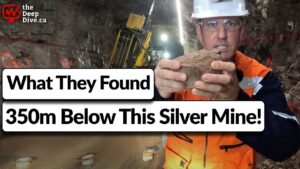Comstock Metals Ltd.(the “Company”) is pleased to announce the assay results received from core hole CO-12-71, the first hole ever drilled to test the Esperanza Showing at the Corona Project (“Corona”) in the Uruachic-Ocampo District of western Chihuahua, Mexico.
Highlights
- First hole ever drilled on the Esperanza zone, approximately 1000 m south of 2012 drilling
- Surface vein width of 15 cm has returned up to 12.43 g/t gold (Au) and 2,634 g/t Silver (Ag)
- CO-12-71 returned 258 g/t Ag, 6.33 g/t Au, 3.82% Pb, and 2.83% Zn, 68 m below surface
- Vein width increases at depth from 15 cm to 1.00 m
- Esperanza vein is a possible part of a larger east-west trending set of structures: 1000 metres west is the Cerro el Cruz prospect, and 300 metres to the east are gold values of 14.71 g/t
- The last 7 metres of high anomalous zinc, lead, and other elements in CO-12-71 suggest good potential to find more mineralization at depth
- Propylitic alteration in CO-12-71 is similar to that found in the distal portions of a porphyry deposit
| Hole number | From-to (metres | ) | Interval (metres | ) | Gold (grams/tonne | ) | Silver (grams/tonne | ) | Lead % | Zinc % |
| CO-12-71 | 125 to 126 | 1.0 | 6.33 | 258 (7.5 oz/T | ) | 3.82 | 2.83 |
The Esperanza Showing is exposed in an old adit dug into an overburden-covered hillside. Mineralization consists of a coarsely banded quartz vein that is up to 30 cm wide hosted within sericite-altered and silicified diorite. Zinc and lead minerals are evident as sphalerite and galena. Grab samples taken in 2002 and 2007 from the adit returned assays of 12.43 g/t Au, 2,634 g/t Ag, 8.35% Pb, 3.84% Cu, and 3.84% Zn (Golden Goliath Resources); and up to 42.6 g/t Au and 76.4 g/t Ag across 15 cm from in-house sampling. The current drill results are considered to be reasonable in light of the more representative core sample of unweathered vein; true width of the zone is estimated to be 70% to 80% of the core length.
Please refer to the website http://www.comstock-metals.com/projects/corona_gold_silver/ for maps and photos of the Esperanza vein.
| Hole Number | Azimuth/Dip | Length (m | ) | Comments |
| CO-12-71 | 230°/60° | 240 | First hole on zone. Designed to test outcropping mineralization approximately 68 metres down-dip |
Hole CO-12-71 was collared in sericitized and silicified andesite tuff, passing into fine-grained diorite halfway to the main vein intercept. The diorite is increasingly altered with depth, marked as strong zones and veins of chlorite and pyrite, suggesting propylitic alteration similar to that found in the distal portions of intrusion-driven hydrothermal systems such as porphyry deposits. Within the propylitic alteration are intervals of up to 7 metres of silicified breccia that is highly anomalous in zinc, lead, and other Esperanza-type elements, suggesting good potential to find more mineralization at depth. One such interval returned 42 g/t silver over one metre, again associated with highly anomalous zinc, lead, copper, and bismuth.
“We are looking forward to following up on our two major discoveries of the porphyry-style mineralization in the Jerry Zone and the high-grade gold-silver Esperanza vein,” commented the Company’s President & CEO Rasool Mohammad. “Similar discoveries in the Ocampo-Uruachic camp have resulted in multimillion ounce gold-silver deposits, and we are fortunate to have indications of similar style of mineralization as the other deposits in the camp.”
Previous drilling reported by Comstock was located at the Northeast Zone, its eastern extension, and the Jerry Zone. These targets are located one kilometre north of Esperanza (see CSL News Releases dated April 2 and May 8, 2012) and over 200 metres above the elevation of Esperanza, in an area of volcanic cover and high-sulphidation alteration. It is postulated that the Esperanza Showing represents a deeper style of mineralization, perhaps more clearly related to intrusive rocks and intermediate epithermal processes. The Esperanza Showing itself may be part of a larger east-west trending set of structures that returned high gold and silver values in earlier programmes. Approximately 1000 metres west is the Cerro el Cruz prospect, reportedly of similar mineral style, and 200 to 300 metres to the east highly anomalous rock and soil samples have been collected, some returning gold values exceeding 14,714 ppb. Further work is required within this prospective corridor, as well as towards the Northeast Zone, which will hopefully lead to a unified exploration model and more drilling.
Analyzed samples consisting of split drill core were analyzed by ALS Chemex Laboratories in Chihuahua, by gravimetric fire assay methods on 50 g pulp samples. Comstock Metals has an industry-standard QA/QC program consisting of inserting standards, blanks, and duplicates into the sample stream to monitor the reliability of assays.
The technical information in this Release has been reviewed by J. Blackwell (P.Geo.), a Qualified Person as defined by National Instrument 43-101.
About Comstock Metals Ltd.
In addition to the Corona project, Comstock also has option agreements covering 10,374 hectares within the prolific White Gold District in the Yukon Territory about 70 kilometres south of Dawson City. The claims were optioned from Shawn Ryan, a Yukon-based prospector responsible for the discovery of two of the prominent gold discoveries in the White Gold district: Kinross Gold’s 1.5 million-ounce Golden-Saddle deposit and Kaminak Gold’s Coffee projects. The Company has completed two soil-sampling programs on the Yukon property with encouraging results.
To learn more, please visit the Company’s website at www.comstock-metals.com.
COMSTOCK METALS LTD.
Rasool Mohammad, B.Sc. (Mining) President & CEO
Neither TSX Venture Exchange nor its Regulation Services Provider (as that term is defined in the policies of the TSX Venture Exchange) accepts responsibility for the adequacy or accuracy of this release.
Contact Information
- Rasool Mohammad, B.Sc. (Mining)
President & CEO
604-639-4533
Larry Johnson
CFO
604-639-4533
www.comstock-metals.com

















